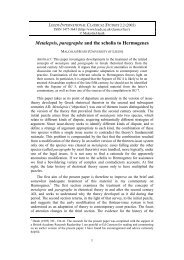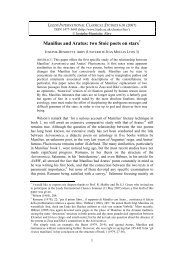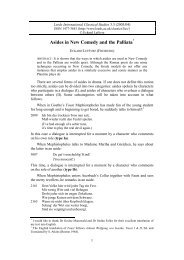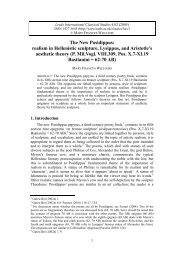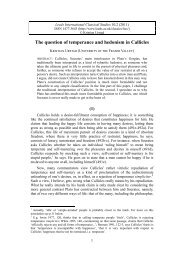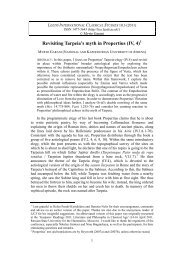Greek Tragedy between Human and Animal - Leeds International ...
Greek Tragedy between Human and Animal - Leeds International ...
Greek Tragedy between Human and Animal - Leeds International ...
You also want an ePaper? Increase the reach of your titles
YUMPU automatically turns print PDFs into web optimized ePapers that Google loves.
CHIARA THUMIGER, GREEK TRAGEDY BETWEEN HUMAN AND ANIMAL<br />
307, 541) to metaphorical uses: for fury <strong>and</strong> mania (Ba. 119 <strong>and</strong> 1229, Or. 791,<br />
HF 862, for lightning <strong>and</strong> mania, <strong>and</strong> 1144); for a range of human passions (Hi.<br />
1300 <strong>and</strong> IA 775 <strong>and</strong> 47 for erotic madness; Tra. 653 for warlike fury embodied<br />
by Ares; OT 1318 for Oedipus’ sufferings). 24<br />
Crisis <strong>and</strong> necessity<br />
We have seen how various textual instantiations establish a continuity rather<br />
than an opposition <strong>between</strong> man <strong>and</strong> animal. Within this background, animals can<br />
convey emotional experiences <strong>and</strong> represent human vulnerability, representing the<br />
human condition in a moment of crisis, or under the constraints of necessity—not<br />
only for the obvious reason that animals are subject to the constriction of human<br />
control. Both animals <strong>and</strong> humans, in fact, are subject to fate. These connection is<br />
especially evident in an image which recurs often in tragic idiom <strong>and</strong> imagery,<br />
that of the yoke <strong>and</strong> yoking. The yoke brings together various suggestions:<br />
imposition; burden <strong>and</strong> doom; partnership; oppression; as well as the division into<br />
two parts, related to choice <strong>and</strong> the importance of balance. The yoke image is<br />
applied to duty (at Aj. 24, as Odysseus says tùd' ØpezÚghn pÒnJ, ‘I volunteered<br />
to undertake this task’) 25 <strong>and</strong> necessity, in several instances, often with reference<br />
to Agamemnon: at Ag. 218-9 we find ¢n£gkaj... lšpadnon, the king’s unwelcome<br />
decision; 26 at Hec. 376 the yoke is the burden of misfortune for the Trojan women<br />
(aÙcšn' ntiqeˆj zugù). A similar image is found in Aj. 123, where the hero is<br />
‘yoked to misfortune’, sugkatšzeugtai, <strong>and</strong> at HF 453 where the yoke is again<br />
the burden of misfortune (¢gÒmeqa zeàgoj oÙ kalÕn nekrîn). Then, there is a<br />
positive side to the yoke, the element of sharing: at HF 121 each member of the<br />
chorus is zugofÒroj, sharing a common burden of longing <strong>and</strong> grief; at 1403<br />
‘yoke of friendship’ is the companionship <strong>between</strong> Heracles <strong>and</strong> Theseus, zeàgÒj<br />
ge f…lion; at Ag. 44, the yoke is used of the Atrides, bound together by<br />
brotherhood <strong>and</strong> a common guilt (timÁj... zeàgoj), as at Hel. 392 (kleinÒn<br />
zugÒn); 27 at Andr. 495, the yoke describes the bond <strong>between</strong> Andromache <strong>and</strong> her<br />
child under a death threat (tÒde sÚgkraton zeàgoj prÕ dÒmwn y»fJ qan£tou<br />
katakekrimšnon, 494-6); at Pho. 330, Eteocles <strong>and</strong> Polynices are two horses that<br />
Oedipus regrets to have let go (¢pozuge…saj); in Or. 1017, Pylades helps Orestes<br />
24<br />
On o stroj see also Davies <strong>and</strong> Kathirithamby (1986) 162-3.<br />
25<br />
Cf. also Ag. 842, where Odysseus is forced to go to Troy against his will (zeucqe…j), likewise at<br />
Phil. 1025 (klopÍ te k¢n£gkV zuge…j).<br />
26<br />
See also IA 443, where the yoke is again used in connection with Agamemnon’s decision<br />
(¢n£gkhj zeÚgmat' mpeptèkamen); Or. 1330, where Electra <strong>and</strong> her brother are bound to the<br />
yoke of their destiny, to be executed by the will of the city; Cho. 795, where Orestes is yoked to<br />
his doom (zugšnt').<br />
27<br />
For a non-poetic usage of the yoke to indicate a shared task, compare the description of the<br />
Spartan army in Thucydides 5.68.3, where the zeugitai or ‘yoked hoplites’ are referred to as<br />
fighting ‘at first yoke’, n tù prètJ zugù (which would support the interpretation of the word<br />
zeug‹tai as ‘class of citizens who are yoked together in the phalanx’ as opposed to ‘owing a yoke<br />
of oxen’).<br />
8



